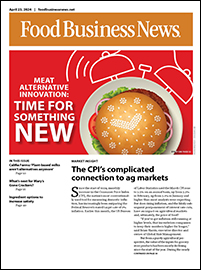BOSTON — As the cultivated meat category continues to evolve, manufacturers and investors are eyeing new and unexpected opportunities in the segment to spark growth, according to speakers at the third annual Cellular Agriculture Innovation Day from Tufts University.
One recent shift in the industry has been to turn away from whole cut applications. Such products have been a focus for innovators, but difficulties with media supply and edible scaffolding have led some manufacturers to turn their attention elsewhere.
“I think companies are now realizing it's going to be a longer time span before we get to this perfect texture whole cut,” said Naya McCartney, PhD, a regulatory safety scientist with Sydney-based Vow. “Being a little bit creative and finding other alternative revenues while you’re perfecting that technology is something that I’m seeing a lot of companies do, and I’m really excited because I think that will help us get through this period of learning.”
Steve Simitzis, partner at food technology startup investor Solvable Syndicate, identified alternative areas of interest such as working with meat processors to create applications that use both traditional and cultivated meat.
“I think meat producers are ultimately going to be the customer of this, and that’s where we can see approaches like bringing in or blending in ground meat, for example, into existing supply chains,” he said. “Let’s get it into fast food, maybe 1% or 2% of fast food to start with. That would be enormously impactful if we were able to just do that, rather than try to push consumers to buy a brand of cultivated steaks.”
Simitzis also pointed to the pet food market as another category where blended opportunities may exist.
“I think there’s a lot of opportunity there (in pet food) to work with existing brands to get ingredients into their supply chain,” Simitzis said. “Now you have to be careful, because pet owners are actually a bit more risk averse than people eating food for themselves. There’s always that fear of, ‘what if my pet gets sick and they can't talk to me about it?’
“So, you know, that is an area where there might be some conservatism, and that’s where some of the existing pet food manufacturers can help.”
Differentiated cell cultures are another area where cultivated meat makers see there may be openings for innovation. For instance, Vow has experimented with 200 different cell types to explore which non-standard cultures may be simpler to produce and which might result in better tasting products.
“We’ve had so many years developing pork, beef, and we did that because those are the easiest to farm,” McCartney said. “That doesn’t mean that they’re the tastiest cells or are the easiest to grow in this way … I think the first principle is how do we use diversity that we can’t use in farming for cell agriculture? I think that gives us, when you look at it that way, such a wide range.”
Co-culturing also may allow for improvements to taste, McCartney said, pointing to examples such as co-culturing fat with muscle to develop a better meat flavor profile. Co-culturing for different species is also a possibility to create unique and exotic flavor profiles. McCartney said that Vow developed a crocodile and quail co-cultured line of cultivated meat that was well received by the company’s foodservice customers.


